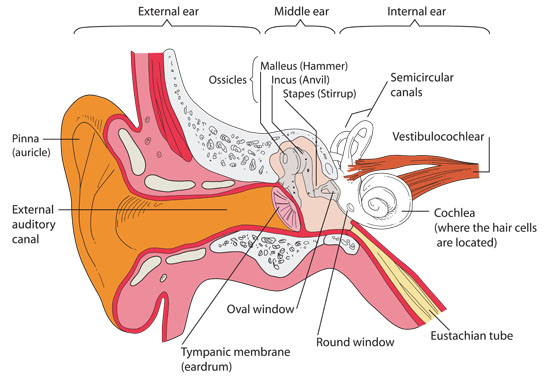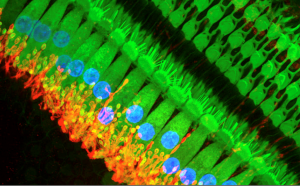Our Hearing and
how the ear works
our hearing

TYPES OF HEARING LOSS
There are many types of hearing loss, but most fall into three types of hearing loss:
Conductive  hearing loss results from a problem in the outer or middle ear that prevents sound from reaching the inner ear. Conductive hearing losses are relatively uncommon and are typically temporary. Most cases of conductive hearing loss can be treated with medication or surgery. When it cannot be treated with those means, most people benefit from the use of a hearing aid.
hearing loss results from a problem in the outer or middle ear that prevents sound from reaching the inner ear. Conductive hearing losses are relatively uncommon and are typically temporary. Most cases of conductive hearing loss can be treated with medication or surgery. When it cannot be treated with those means, most people benefit from the use of a hearing aid.
Common causes of conductive hearing loss are:
- Fluid in the middle ear from colds or viruses
- Ear infections
- Allergies
- Perforated eardrum
- Impacted cerumen (earwax)
- Benign tumours
- Swimmer’s Ear (exostosis)
- Foreign object in the ear
- Absence or malformation of the outer ear, ear canal, or middle ear
*An analogy of this type of hearing loss is like having your garden hose (your ear canal) closed off or blocked by something, with the sound from outside of the ear canal not actually reaching the ear drum for it to vibrate, sending the signal further up the auditory pathway.
 Sensorineural hearing loss is the most common type of hearing loss and is the result of a problem in the inner ear or auditory nerve. It occurs when the tiny hair-like cells (stereocilia) in the cochlea and/or the auditory nerve are missing or damaged, as both result in weakened nerve signals being sent to the brain.
Sensorineural hearing loss is the most common type of hearing loss and is the result of a problem in the inner ear or auditory nerve. It occurs when the tiny hair-like cells (stereocilia) in the cochlea and/or the auditory nerve are missing or damaged, as both result in weakened nerve signals being sent to the brain.
Common causes of sensorineural hearing loss are:
- Illnesses
- Drugs that are toxic to hearing (ototoxicity)
- Genetics
- Aging
- Head trauma
- Malformation of the inner ear
- Exposure to loud noise
*An analogy of this type of hearing loss is like listening to your brand new stereo Hi Fi system and then connecting your 50 year old speaker wire that has been damaged over the years, through chair legs resting on it, or pets may have chewed the wire, ending with ‘frayed’ or broken wires (your damaged auditory nerve) which now do not take the ‘full complete signal’ of your music further to the speakers (further up the cortex in the brain) for the necessary fine tuning. You may end up with a slightly ‘distorted’ sound before it gets to the cortex. No matter how loud you turn the HI FI stereo up, it may still be distorted.
Mixed hearing loss is a combination of conductive hearing loss and sensorineural hearing loss. When there is damage to either the outer or middle ear and the inner ear or auditory nerve, mixed hearing loss occurs. The sensorineural hearing loss is permanent while the conductive hearing loss may be reversible. Mixed hearing loss typically occurs when the ear sustains some type of trauma or injury, but can also result from a combination of the possible causes listed above.
- Mild hearing loss: speech is perceived at a spoken level, but problems can occur with low voices or when the speaker gets further away. Most familiar sounds are perceived accurately.
- Moderate hearing loss: Speech is perceived with raised voices. The person with hearing loss understands better when they look at the speaker. Some familiar sounds are still perceived accurately.
- Severe hearing loss: Speech is perceived with raised voices close to the ear. Only loud noises are heard.
- Profound hearing loss: No speech perception. Only very loud noises are heard.
- Complete hearing loss (deafness): the average loss is 120dB. No sound is perceived.
how we hear
Sound waves enter your outer ear, collected by what’s called the pinna. This funnels these waves through your ear canal and into your middle ear, which are separated by the tympanic membrane, also known as the eardrum. This very fine membrane is flexible and begins to move when sound vibrations hit it, which in turn starts to move the ossicles—the three small bones in the middle ear: the malleus (hammer), incus (anvil), and stapes (stirrup). These bones work together to amplify the sound waves and move them to your inner ear. The middle ear is often where hearing loss begins to occur, so it’s important that all of these moving parts are free of damage.
The inner ear is full of fine hair-like cells called ‘stereocilia’, full of nerve endings, within a spiral-shaped organ called the cochlea. These tiny hair cells collect information from sound vibrations coming in from the middle ear and transmit those vibrations into nerve impulses, via the auditory nerve, further up the higher cortex neurons in your brain. The brain processes and interprets these nerve impulses as sound in the auditory cortex, allowing us to hear sounds and identify them around us.



